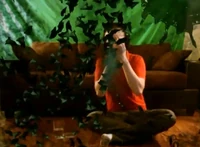No edit summary |
Tag: Visual edit |
||
| (2 intermediate revisions by the same user not shown) | |||
| Line 34: | Line 34: | ||
! scope="col" |Notes |
! scope="col" |Notes |
||
|- |
|- |
||
| + | | colspan="1" rowspan="2"|[[Ginny Weasley]] |
||
| − | | |
||
| + | |[[18 June]], [[1996]] |
||
| − | | |
||
| + | |She used this hex on [[Draco Malfoy]] to escape [[Umbridge]]'s office. |
||
| − | | |
||
|- |
|- |
||
| + | |[[1 September]], 1996 |
||
| − | | |
||
| + | |[[Slughorn]] asked Ginny to join the [[Slug Club]] after seeing her a this hex on [[Zacharias Smith]] aboard the [[Hogwarts Express]]. |
||
| − | | |
||
| − | | |
||
|} |
|} |
||
| + | == Known practitioners == |
||
| + | * [[Miranda Goshawk]] |
||
| + | * [[Ginny Weasley]] |
||
==Behind the scenes== |
==Behind the scenes== |
||
[[File:Wonderbook - Bat-Bogey Hex.jpg|thumb|200px|A user of ''Wonderbook'' being affected by the Bat-Bogey Hex]] |
[[File:Wonderbook - Bat-Bogey Hex.jpg|thumb|200px|A user of ''Wonderbook'' being affected by the Bat-Bogey Hex]] |
||
| − | + | ''[[Wonderbook: Book of Spells]]'' gives players a chance to see the Bat-Bogey Hex in action, though they are not actually taught how to cast it. |
|
| − | |||
==Appearances== |
==Appearances== |
||
*''[[Harry Potter and the Order of the Phoenix]]'' |
*''[[Harry Potter and the Order of the Phoenix]]'' |
||
Revision as of 22:44, 31 December 2014
- "However, when a person’s bogies turn into black bats, which crawl out of their nostrils and flap away you can generally count on them shutting up long enough for you to talk for a change."
- — Miranda Goshawk[src]
The Bat-Bogey Hex (incantation unknown) was a hex invented by Miranda Goshawk.[1] The incantation is unknown. It turned the target's bogeys into large, black bats that flew out of their nose.[1]
The use of the Bat-Bogey Hex on a non-human target, such as a chicken, can be fatal, and may result in punishment by the Wizengamot.[2]
History
Early 20th century
This spell was invented by Miranda Goshawk when she was young. Growing up as the youngest of nine sisters, she often found it difficult to get her older sisters to listen to her, and sometimes relied on this spell to silence them long enough to allow her to speak. For example, she cast it on her sister Diadema to get her to return clothing she borrowed without permission; on her sister Romilda to get her to keep out of her room when she did not want to be disturbed; and on her sister Tangwystl when she wanted to keep her quiet so that she could do her homework.[1]
Sometime between its invention by Goshawk and the late 1990s, the Bat-Bogey Hex had been involved in several notable incidents throughout wizarding history.[3]
Late 20th century
Ginny Weasley was a noted practitioner of the hex, and used it to good effect on two occasions. The first use was to overpower Draco Malfoy in Dolores Umbridge's office during her tyrannical tenure as Headmistress of Hogwarts, allowing herself, her brother Ron, and their companions, Neville Longbottom, and Luna Lovegood, to escape[4]. The second occasion was used on Zacharias Smith, who annoyed Ginny on the Hogwarts Express by asking her exactly what occurred at the Battle of the Department of Mysteries. This use garnered the attention of Horace Slughorn, who invited Ginny to take lunch with him as part of his Slug Club.[5] Ginny may have also used this spell on her brother George, as he once mentioned her skill to Harry Potter.
The Bat-Bogey Hex was the subject of a question on the 1996 Theory of Charms O.W.L.[3]
Known uses
| Caster(s) | Date | Notes |
|---|---|---|
| Ginny Weasley | 18 June, 1996 | She used this hex on Draco Malfoy to escape Umbridge's office. |
| 1 September, 1996 | Slughorn asked Ginny to join the Slug Club after seeing her a this hex on Zacharias Smith aboard the Hogwarts Express. |
Known practitioners
Behind the scenes

A user of Wonderbook being affected by the Bat-Bogey Hex
Wonderbook: Book of Spells gives players a chance to see the Bat-Bogey Hex in action, though they are not actually taught how to cast it.
Appearances
- Harry Potter and the Order of the Phoenix
- Harry Potter and the Order of the Phoenix (film) (Mentioned only)
- Harry Potter and the Half-Blood Prince
- Wonderbook: Book of Spells
- J. K. Rowling's Official Site (Mentioned only)
Notes and references
- ↑ 1.0 1.1 1.2 1.3 Wonderbook: Book of Spells
- ↑ Wizards' Ordinary Magic and Basic Aptitude Test, Grade 1, Question 6
- ↑ 3.0 3.1 Harry Potter and the Order of the Phoenix (film) (see this image)
- ↑ Harry Potter and the Order of the Phoenix, Ch. 33
- ↑ Harry Potter and the Half-Blood Prince,Ch. 7
